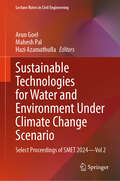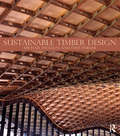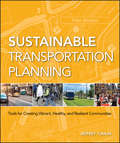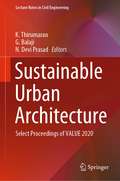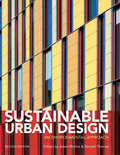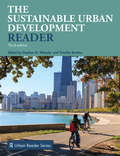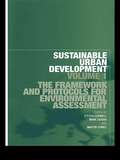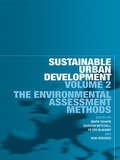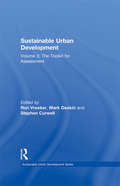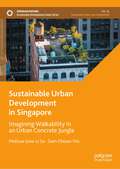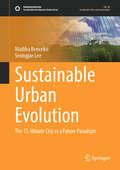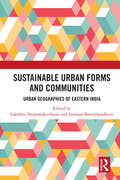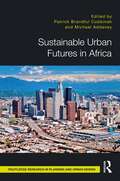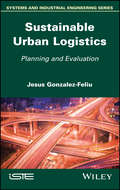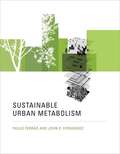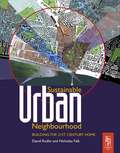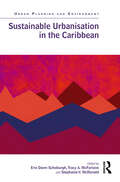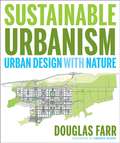- Table View
- List View
Sustainable Technologies for Water and Environment Under Climate Change Scenario: Select Proceedings of SMET 2024—Vol 2 (Lecture Notes in Civil Engineering #720)
by Hazi Azamathulla Arun Goel Mahesh PalThis book discusses various aspects of water resources and environmental planning for the effective use and management of water, land, and air. Sustainable development is a holistic and systemic approach that takes into account analysis of multiple objectives, impact and risk analysis, and decision-making at the grass-roots level. Remote sensing and GIS data coupled with AI & ML techniques plays a crucial and integral role in this endeavour especially for water and environment-related problems. Remote sensing and geographic information system-based approach is required for the sustainable development of land, air, and water resources for proper utilization of resources based on their potential and limitations. The approach involves the extraction of information on soils, water resources (both surface and ground water), and integrating them with social, cultural, and economic needs of people using a GIS as a tool. Further, this integration helps in the generation of an action plan identifying specific interventions in a watershed based on contemporary technology, in consultation not only with scientific specialists in agriculture, horticulture, water resources, land use, forestry, and soil conservation, but also with social scientists, nongovernmental organizations, and beneficiary farmers in the watershed. This book also addresses recent applications of AI/ML/geoinformatics in landslides monitoring, flood mapping and management, land use/land cover mapping, water quality mapping, urban planning and development, traffic management and analysis, construction, and infrastructure development as well as mapping of natural resources. It is a state of art work complied in the edited book which will be useful for the students, researchers, academicians, and policy makers dealing with sustainable management of water resources and environment under climate change scenario with applications of AI & ML techniques in a lucid manner.
Sustainable Timber Design: Construction For 21st Century Architecture
by Michael Dickson Dave ParkerThis new resource covers the material selection, structural design and connections detailing of truly sustainable timber buildings through: consideration of the nature of wood and the heritage of timber construction, including the importance of forestry and conservation a review of modern techniques to improve the durability, fire resistance and predictability of structural timber elements and their vital connections analysis of the many architectural and structural options, from roundwood shells through glulam arches and gridshells to long span hybrid structures case studies from around the world illustrating the principles discussed and the true potential of timber construction Historically there has been an imbalance between the availability of information on structural timber design and the much more widespread familiarity with traditional structural materials such as steel and concrete. This book aims to help redress the balance by presenting the essential design principles involved in the creation of elegant, user-friendly timber buildings that are practical, economic, and thoroughly sustainable. Designed to support specialist study into the benefits of 21st Century timber engineering, this book also offers architects, engineers and other construction professionals practical advice on all aspects of modern timber architecture.
Sustainable Tools for Precarious Times: Performance Actions in the Americas (Contemporary Performance InterActions)
by Claudette Lauzon Natalie Alvarez Keren ZaiontzThis book charts the changing frontiers of activism in the Americas. Travelling Canada, the US, the US-Mexico border, Chile, Argentina, Brazil, Cuba, Colombia, and Indigenous territories on Turtle Island, it invites readers to identify networks, clusters, and continuities of art-activist tactics designed to exceed the event horizon of the performance protest. Essays feature Indigenous artists engaging in land-based activism and decolonial cyberactivism, grass-roots movements imagining possible futures through cross-sector alliance building, art-activists forwarding tactics of reinvention, and student groups in the throes of theatrical assembly. Artist pages, interspersed throughout the collection, serve as animated, first-person perspectives of those working on the front lines of interventionist art. Taken together, the contributions offer a vibrant picture of emergent tactics and strategies over the past decade that allow art-activists to sustain the energy and press of political resistance in the face of a whole host of rights emergencies across the Americas.Project Artists: - The Great Collective Cough-In – L.M. Bogad - Le Temps d’une Soupe – ATSA - For Freedoms – Hank Willis Thomas and Eric Gottesman - Down with Self-Management! Re-Booting Ourselves as Feminist Servers – subRosa - Journey for Activism and Sustainability Escola de Ativismo - Unstoppable – micha cárdenas, Patrisse Cullors, Chris Head and Edxie Betts - Listen to Black Women – Syrus Marcus Ware - Notes on Sustainable Tools – Fred Moten and Stefano Harney, with Suné Woods - The Mirror Shield Project – Cannupa Hanska Luger - The Human Billboard Project – Leah Decter, with Stop Violence Against Aboriginal Women Action Group
Sustainable Transportation Planning
by Jeffrey Tumlin"The Great American Dream of cruising down the parkway, zipping from here to there at any time has given way to a true nightmare that is destroying the environment, costing billions and deeply impacting our personal well-being. Getting from A to B has never been more difficult, expensive or miserable. It doesn't have to be this way. Jeffrey Tumlin's book Sustainable Transportation Planning offers easy-to-understand, clearly explained tips and techniques that will allow us to quite literally take back our roads. Essential reading for anyone who wants to drive our transportation system out of the gridlock."-Marianne Cusato, home designer and author of Get Your House Right: Architectural Elements to Use and Avoid??The book is full of useful ideas on nearly every page.?? Bill DiBennedetto of Triple PunditAs transportations-related disciplines of urban planning, architecture, landscape architecture, urban economics, and social policy have undergone major internal reform efforts in recent decades Written in clear, easy-to-follow language, this book provides planning practitioners with the tools they need to achieve their cities? economic development, social equity and ecological sustainability goals. Starting with detailed advice for improving each mode of transportation, the book offers guidance on balancing the needs of each mode against each other, whether on a downtown street, or a small town neighborhood, or a regional network.
Sustainable Urban Architecture: Select Proceedings of VALUE 2020 (Lecture Notes in Civil Engineering #114)
by K. Thirumaran G. Balaji N. Devi PrasadThis book presents select proceedings of the International Conference on Visionary Action towards Liveable Urban Environments (VALUE 2020). Various topics covered in this book include context responsive architecture, green architecture, energy efficient buildings, energy conservation, inclusive spatial environments, security in buildings and cities, green/smart/ intelligent architecture, sustainable mobility and smart communities. This book will be a valuable reference for students, researchers, and professionals interested in built environment and allied fields.
Sustainable Urban Design: An Environmental Approach
by Randall Thomas Adam RitchieBy the end of the twenty-first century it is thought that three-quarters of the world’s population will be urban; our future is in cities. Making these cities healthy, vibrant and sustainable is an exceptional challenge which this book addresses. It sets out some of the basic principles of the design of our future cities and, through a series of carefully-selected case studies from leading designers’ experience, illustrates how these ideas can be put into practice. Building on the first edition's original format of design guidance and case studies, this new edition updates the ideas and techniques resulting from further research and practice by the contributors. This book emphasises the enormous progress made towards exciting new designs that integrate good design with resource efficiency.
Sustainable Urban Development Reader (Routledge Urban Reader Series)
by Timothy Beatley Stephen M. WheelerBuilding on the success of its second edition, the third edition of the Sustainable Urban Development Reader provides a generous selection of classic and contemporary readings giving a broad introduction to this topic. It begins by tracing the roots of the sustainable development concept in the nineteenth and twentieth centuries, before presenting readings on a number of dimensions of the sustainability concept. Topics covered include land use and urban design, transportation, ecological planning and restoration, energy and materials use, economic development, social and environmental justice, and green architecture and building. All sections have a concise editorial introduction that places the selection in context and suggests further reading. Additional sections cover tools for sustainable development, international sustainable development, visions of sustainable community and case studies from around the world. The book also includes educational exercises for individuals, university classes, or community groups, and an extensive list of recommended readings.The anthology remains unique in presenting a broad array of classic and contemporary readings in this field, each with a concise introduction placing it within the context of this evolving discourse. The Sustainable Urban Development Reader presents an authoritative overview of the field using original sources in a highly readable format for university classes in urban studies, environmental studies, the social sciences, and related fields. It also makes a wide range of sustainable urban planning-related material available to the public in a clear and accessible way, forming an indispensable resource for anyone interested in the future of urban environments.
Sustainable Urban Development Volume 1: The Framework and Protocols for Environmental Assessment (Sustainable Urban Development Series #Vol. 1)
by Mark Deakin Martin Symes Steven CurwellBased on original research, this first volume of a set of groundbreaking new books sets out a framework for analyzing sustainable urban development and develops a set of protocols for evaluating the sustainability of urban development. Protocols included are for sustainable urban planning, urban property development, urban design, the construction, operation and use of buildings. Using these protocols, the book goes on to provide a directory of environmental assessment methods for evaluating the sustainability of urban development and also maps out how these assessment methods are being transformed to evaluate the environmental, economic and social sustainability of urban development. Web-based applications are increasingly being used to support this transformation and the contributors deftly cover this application and issues concerning the use of information and communication technologies for evaluating the sustainability of urban development are also dealt with. With its multidisciplinary approach, Sustainable Urban Development presents key new material for postgraduates and professionals across the built environment.
Sustainable Urban Development Volume 2: The Environmental Assessment Methods (Sustainable Urban Development Series #Vol. 2)
by Peter Nijkamp Mark Deakin Gordon Mitchell Ron VreekerIn this book, the second of a three-volume series, leading authorities on the methodology of environmental assessment provide a unique insight into questions of critical importance to sustainable urban development. Using the framework and protocols set out in Volume 1, Volume 2 examines how well the environmental assessment methods evaluate the ecological integrity of urban development and equity of the resulting resource distribution. The examination focuses on: the instruments of environmental assessment approaches to environmental assessment based in systems-thinking methods for environmental, economic and social assessments their use in evaluating the sustainability of urban development. The Sustainable Urban Development Series contains the research and debate of the BEQUEST (Building, Environmental Quality Evaluation for Sustainability) network funded by the European Commission. Together the books provide a framework, set of protocols, environmental assessment methods and toolkit for policy makers, academics, professionals and advanced level students in urban planning and studies, as well as other areas of the built environment.
Sustainable Urban Development Volume 3: The Toolkit for Assessment (Sustainable Urban Development Series)
by Mark Deakin Ron Vreeker Stephen CurwellThe third volume of the Sustainable Urban Development Series outlines the BEQUEST toolkit that helps link protocol with the assessment methods currently available for evaluating the sustainability of urban development. It details the decision support mechanisms developed for users of the system to guide them in selecting the appropriate assessment methods for a variety of evaluations.This book provides case studies drawn from locations across Europe, and also provides best practice examples demonstrating those protocols that planners, property developers and design and construction professionals have followed, and how they have selected the assessment methods they need to best evaluate the sustainability of cities, districts, neighbourhoods and buildings.
Sustainable Urban Development Volume 4: Changing Professional Practice (Sustainable Urban Development Series #Vol. 4)
by Ian Cooper Martin SymesThis new book explores how the professions responsible for enhancing the built environment's sustainability seek to deliver this new agenda, offering multi-perspective case studies and discussion to argue for a rethinking of the role of urban development professional. Showing how sustainability is rapidly becoming the norm for practitioners, the authors consider new types of professional knowledge, relationships between planning systems and property development, links between public and private sector organisations, ideas about long term responsibilities and new working practices for engaging with the public.
Sustainable Urban Development in Singapore: Imagining Walkability in an Urban Concrete Jungle (Sustainable Development Goals Series)
by Melissa Liow Li Sa Sam Choon-YinThis book offers theoretical and practical insights into land use, transport, and national policies in one of world’s well-known urban concrete jungle, none other than the Singapore city. The emphasis is situated on Singapore’s attempt to promote walking and cycling. Greater appreciation of walkability thrives on Singapore’s rich history, green city, people and the gastronomic kopitiam and hawker culture. The book offers a comprehensive coverage of walkability as a crucial component of urban design to reduce vehicular congestion with the associated carbon emissions, foster a healthy lifestyle and community participation and create jobs to help the economy. A high income per capita and an aging society, lessons drawn from Singapore’s experience will be useful to other societies. Scholars in sustainable tourism field, urban planners, government bodies, tourist boards, entrepreneurs, national parks board, residents, and inbound travellers will benefit from reading the book.
Sustainable Urban Environments
by Henk Visscher Ellen M. van Bueren Laure Itard Hein Van BohemenThe urban environment - buildings, cities and infrastructure - represents one of the most important contributors to climate change, while at the same time holding the key to a more sustainable way of living. The transformation from traditional to sustainable systems requires interdisciplinary knowledge of the re-design, construction, operation and maintenance of the built environment. Sustainable Urban Environments: An Ecosystem Approach presents fundamental knowledge of the built environment. Approaching the topic from an ecosystems perspective, it shows the reader how to combine diverse practical elements into sustainable solutions for future buildings and cities. You'll learn to connect problems and solutions at different spatial scales, from urban ecology to material, water and energy use, from urban transport to livability and health. The authors introduce and explore a variety of governance tools that support the transformation process, and show how they can help overcome institutional barriers. The book concludes with an account of promising perspectives for achieving a sustainable built environment in industrialized countries. Offering a unique overview and understanding of the most pressing challenges in the built environment, Sustainable Urban Environments helps the reader grasp opportunities for integration of knowledge and technologies in the design, construction and management of the built environment. Students and practitioners who are eager to look beyond their own fields of interest will appreciate this book because of its depth and breadth of coverage.
Sustainable Urban Evolution: The 15-Minute City as a Future Paradigm (Sustainable Development Goals Series)
by Madiha Bencekri Seungjae LeeThis book, Sustainable Urban Evolution, delves into the transformative potential of the 15-minute city concept, an innovative urban planning model crafted to address pressing issues like urban sprawl, environmental sustainability, resilience, and the demand for livable cities. In a world where urban areas are striving to harmonize growth with environmental and social well-being, this book provides timely and strategic insights. Bridging the divide between urban planning theory and practical implementation, Sustainable Urban Evolution equips readers with a deep understanding of how the 15-minute city model can be applied to create dynamic, efficient, and sustainable urban environments. It explores the concept&’s origins, key principles such as compactness and multimodality, and highlights its diverse benefits, including enhanced environmental sustainability, social equity, and economic resilience. By showcasing global case studies and real-world examples, the book demonstrates how the 15-minute city model can be tailored to various urban settings. It offers practical strategies and frameworks to guide successful implementation, making it an indispensable resource for urban planners, policymakers, academics, and community leaders dedicated to advancing sustainable urban development.
Sustainable Urban Forms and Communities: Urban Geographies of Eastern India
by Sumana Bandyopadhyay Lakshmi SivaramakrishnanThis volume discusses the patterns and trends of urbanization in West Bengal - one of the most urbanized states of India in the early part of the 20th Century. It focuses on the emerging urban landscapes of the state and neighbouring areas on building sustainable urban units and sustainable communities. The book explores the changing urban geographies of the emerging towns of the state and discusses how proper governance can help them to change into sustainable urban units. It presents the historical context of urbanization of West Bengal and traces the factors responsible for the urban primacy of the state. It discusses topics such as the development of the spatial patterns and urbanization, spatial trends of urban growth using remote sensing and GIS techniques, well-being and resilience in the urban society, impact of urbanization on the health status of its citizens, and decentralized governance for inclusive and sustainable development of cities. It also focuses on urban growth, land-use change and its impact on the urban environment. Based on empirical research, this book will be useful for students, teachers and researchers of geography, urban geography, urban studies, urban development and planning, regional planning urban sociology, politics, and urban economics. It will also be of interest to geographers, urban planners, community of geographers, professionals engaged in the discipline, and those interested in the urban geography of West Bengal and eastern India.
Sustainable Urban Futures in Africa
by Patrick Brandful CobbinahSustainable Urban Futures in Africa provides a variety of conventional and emerging theoretical frameworks to inform understandings and responses to critical urban development issues such as urbanisation, climate change, housing/slum, informality, urban sprawl, urban ecosystem services and urban poverty, among others, within the context of the sustainable development goals (SDGs) in Africa. This book addresses topics including challenges to spatial urban development, how spatial planning is delivered, how different urbanisation variables influence the development of different forms of urban systems and settlements in Africa, how city authorities could use old and new methods of land administration to produce sustainable urban spaces in Africa, and the role of local activism is causing important changes in the built environment. Chapters are written by a diverse range of African scholars and practitioners in urban planning and policy design, environmental science and policy, sociology, agriculture, natural resources management, environmental law, and politics. Urban Africa has huge resource potential – both human and natural resources – that can stimulate sustainable development when effectively harnessed. Sustainable Urban Futures in Africa provides support for the SDGs in urban Africa and will be of interest to students and researchers, professionals and policymakers, and readers of urban studies, spatial planning, geography, governance, and other social sciences.
Sustainable Urban Logistics: Planning and Evaluation
by Jesus Gonzalez-FeliuUrban logistics has been a subject of interest to researchers and practitioners for more than 20 years in France and Europe, and more than 40 in the United States. Nevertheless, the subject remains difficult to address by a lack of unification in the definitions and proposed methods but also by what makes its great richness: the diversity of actors and the pluridisciplinarity of the methods and techniques available.This book, which synthesizes more than 10 years of personal research on the subject, but also experience within different teams and projects, intends to bring a unified vision (and more and more followed at the international level) on logistics planning Urban development. It begins with an overview of research in urban logistics and then describes and defines the main components: flows, actors, infrastructures, management components, technologies, regulations and financing actions. A unified vision of these elements as well as the definition of sustainable urban logistics is proposed.Then, the book presents the basics of planning and managing sustainable urban logistics. First, the basics of the before-after analysis are introduced, not only for the experiments but also for the simulation of scenarios. To carry out this type of analysis, two main groups of methods are needed: methods for estimating flows and methods for calculating evaluation indicators. The book presents the main global standards and dominant models for the estimation of the urban freight transport demand, i.e. of freight transport needs in urban areas. Then it presents the methods for estimating and simulating transport and distribution schemes (i.e. transport supply) as well as a proposal for integrated supply-demand modeling. All these methods are presented for immediate application to practitioners, accompanied by summary tables and parameters necessary for their implementation.As far as evaluation is concerned, the book presents a framework for the choice of sustainable indicators and scorecards. Second, the main methods for economic, environmental, social and accessibility assessment are presented. They are accompanied by tables and figures necessary for their implementation. Finally, the main applications of the proposed methods are introduced. The book is meant to be a practical guide to applying the main methods from scientific research to a practical context, and presents examples of quantified and explained application. It is thus the first book that summarizes and presents the main unified methods to help the different decision-makers to implement them in their actions of planning and management of the urban logistics and the transport of goods in town.
Sustainable Urban Metabolism
by Paulo Ferrao John E. FernandezA unified framework for analyzing urban sustainability in terms of cities' inflows and outflows of matter and energy.Urbanization and globalization have shaped the last hundred years. These two dominant trends are mutually reinforcing: globalization links countries through the networked communications of urban hubs. The urban population now generates more than eighty percent of global GDP. Cities account for enormous flows of energy and materials—inflows of goods and services and outflows of waste. Thus urban environmental management critically affects global sustainability. In this book, Paulo Ferrão and John Fernández offer a metabolic perspective on urban sustainability, viewing the city as a metabolism, in terms of its exchanges of matter and energy. Their book provides a roadmap to the strategies and tools needed for a scientifically based framework for analyzing and promoting the sustainability of urban systems. Using the concept of urban metabolism as a unifying framework, Ferrão and Fernandez describe a systems-oriented approach that establishes useful linkages among environmental, economic, social, and technical infrastructure issues. These linkages lead to an integrated information-intensive platform that enables ecologically informed urban planning. After establishing the theoretical background and describing the diversity of contributing disciplines, the authors sample sustainability approaches and tools, offer an extended study of the urban metabolism of Lisbon, and outline the challenges and opportunities in approaching urban sustainability in both developed and developing countries.
Sustainable Urban Metabolism
by Paulo Ferrão John E. FernándezUrbanization and globalization have shaped the last hundred years. These two dominanttrends are mutually reinforcing: globalization links countries through the networked communicationsof urban hubs. The urban population now generates more than eighty percent of global GDP. Citiesaccount for enormous flows of energy and materials -- inflows of goods and services and outflows ofwaste. Thus urban environmental management critically affects global sustainability. In this book,Paulo Ferrão and John Fernndez offer a metabolic perspective on urban sustainability, viewingthe city as a metabolism, in terms of its exchanges of matter and energy. Their book provides aroadmap to the strategies and tools needed for a scientifically based framework for analyzing andpromoting the sustainability of urban systems. Using the concept of urbanmetabolism as a unifying framework, Ferrão and Fernandez describe a systems-oriented approachthat establishes useful linkages among environmental, economic, social, and technical infrastructureissues. These linkages lead to an integrated information-intensive platform that enablesecologically informed urban planning. After establishing the theoretical background and describingthe diversity of contributing disciplines, the authors sample sustainability approaches and tools,offer an extended study of the urban metabolism of Lisbon, and outline the challenges andopportunities in approaching urban sustainability in both developed and developing countries.
Sustainable Urban Neighbourhood: The Sustainable Urban Neighbourhood
by David Rudlin Nicholas FalkThis successful title, previously known as 'Building the 21st Century Home' and now in its second edition, explores and explains the trends and issues that underlie the renaissance of UK towns and cities and describes the sustainable urban neighbourhood as a model for rebuilding urban areas.The book reviews the way that planning policies, architectural trends and economic forces have undermined the viability of urban areas in Britain since the Industrial Revolution. Now that much post-war planning philosophy is being discredited we are left with few urban models other than garden city inspired suburbia. Are these appropriate in the 21st century given environmental concerns, demographic change, social and economic pressures? The authors suggest that these trends point to a very different urban future.The authors argue that we must reform our towns and cities so that they become attractive, humane places where people will choose to live. The Sustainable Urban Neighbourhood is a model for such reform and the book describes what this would look like and how it might be brought about.
Sustainable Urban Regeneration: Insights and Evaluation from a UK Housing Association
by Angela Lee Kevin Dean Claudia TrilloThis book provides a deep insight into urban regeneration schemes and explores the parameters of what is deemed a sustainable development, before appraising existing schemes’ evaluation models for the sustainable return on investment. The authors present a new practical evaluation tool that suggests quantifiable benefits for all urban regeneration stakeholders. This new method enables the gauging of the full sustainable impact, from a given outlay of money invested in a housing-led urban regeneration scheme, through an evidence-based proof and can be used to: Better fulfil sustainability criteria in terms of all three aspects of the triple bottom line and contribute in a more sustainable way to address the United Nation’s Sustainable Development Goal 11 Reduce financial waste and plug the gap created by the recent economic shortfall which is impacting on housing associations, tenants and communities alike Evaluate historical housing-led urban regeneration schemes and model future schemes. The method can be used as a strategic decision making or management tool, with schemes being able to be planned in, prioritised or carried out in a targeted and strategic manner; and it can be used for modelling purposes, for publicity purposes and alongside existing tools. This book provides a unique method of fully and sustainably evaluating housing-led urban regeneration schemes, useful for planners, strategic management, local authorities, housing associations, the construction industry and built environment students alike.
Sustainable Urban Transitions: Research, Policy and Practice (Urban Sustainability)
by Zaheer AllamThis book aims to explore how sustainability transitions can be explored in current and future cities and how research and policy approaches can be applied to change urban life as we know it, hence aligning the two thematic of urban science and future science, for achieving deep decarbonization. On this, the discourse on philosophy, ethics, and morality appertaining to sustainable cities and urban transitions, across disciplines, are also welcomed as it provides a deeper understanding of humanity in future scenarios. Chapter 08 is available open access under a Creative Commons Attribution 4.0 International License via link.springer.com.
Sustainable Urbanisation in the Caribbean (ISSN)
by Stephanie V. McDonald Dawn Schoburgh, Edited by ErisSustainable Urbanisation in the Caribbean critically examines the socio-geographic context of island states, prioritising the nuanced experiences of Caribbean island states and territories that are largely considered small island developing states (SIDS), against the backdrop of the UN Sustainable Development Goals (SDGs).Increases in urban density place enormous pressure on existing infrastructures and natural resources, exacerbating social inequalities and environmental risks. While the UN SDGs aim to mitigate these risks, the reality of implementing these goals in the context of SIDS is complex. Whereas Sustainable Urbanisation in the Caribbean does not claim to be a comprehensive assessment of policy responses to the SDGs, this edited volume seeks to generate problem-focused, policy-relevant, demand-driven research, thereby permitting the geographical contexts of island states to contribute to the development of proper causal theory about sustainable urbanisation.This book will be of interest to students of public policy, urban sustainability and climate change, as well as government policy analysts, development practitioners, urban planners and UN agencies working in SIDS.
Sustainable Urbanism
by Douglas FarrWritten by the chair of the LEED-Neighborhood Development (LEED-ND) initiative, Sustainable Urbanism: Urban Design with Nature is both an urgent call to action and a comprehensive introduction to "sustainable urbanism"--the emerging and growing design reform movement that combines the creation and enhancement of walkable and diverse places with the need to build high-performance infrastructure and buildings.Providing a historic perspective on the standards and regulations that got us to where we are today in terms of urban lifestyle and attempts at reform, Douglas Farr makes a powerful case for sustainable urbanism, showing where we went wrong, and where we need to go. He then explains how to implement sustainable urbanism through leadership and communication in cities, communities, and neighborhoods. Essays written by Farr and others delve into such issues as: Increasing sustainability through density. Integrating transportation and land use. Creating sustainable neighborhoods, including housing, car-free areas, locally-owned stores, walkable neighborhoods, and universal accessibility. The health and environmental benefits of linking humans to nature, including walk-to open spaces, neighborhood stormwater systems and waste treatment, and food production. High performance buildings and district energy systems.Enriching the argument are in-depth case studies in sustainable urbanism, from BedZED in London, England and Newington in Sydney, Australia, to New Railroad Square in Santa Rosa, California and Dongtan, Shanghai, China. An epilogue looks to the future of sustainable urbanism over the next 200 years.At once solidly researched and passionately argued, Sustainable Urbanism is the ideal guidebook for urban designers, planners, and architects who are eager to make a positive impact on our--and our descendants'--buildings, cities, and lives.
Sustainable Urbanism in China
by Ali Cheshmehzangi Ayyoob Sharifi Ayotunde DawoduSustainable Urbanism in China explores the notion of "Sustainable Urbanism" by considering the role sustainable neighborhood planning plays in the larger picture of sustainable urbanism and suggests innovations and best practices that are either developed or adopted by China. These are narrated as lessons learnt for other countries where we see similar trends of development patterns or emerging practices. Through various explorations of challenges, paradigms, and innovations of urban sustainability, this book highlights how planning, policy, and design are forming and reforming in the context of China. These are offered through a set of guidelines and pathways for urban sustainability at the scale of neighborhoods/communities or districts in a wider context of urban environments, as well as strategies for planners, developers, policy makers, and educators in the field of the built environment. Through a comprehensive overview of urban sustainability practices in China, this book investigates 12 case study projects. These comprehensive explorations should in turn help construct the future directions of China’s sustainable urban development and provide innovative pathways of sustainable urbanism in China and around the globe.
